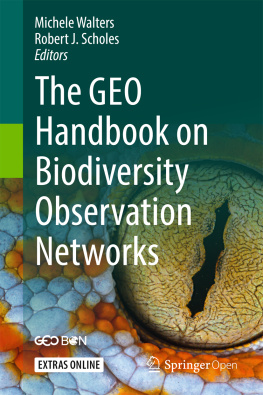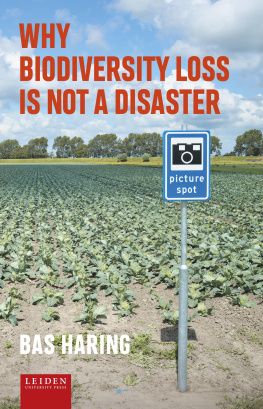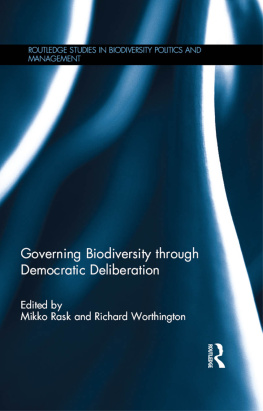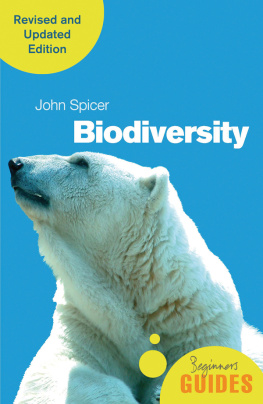1. Working in Networks to Make Biodiversity Data More Available
Abstract
It became apparent a few decades ago that biodiversity is declining worldwide at nearly unprecedented rates. This poses ethical and self-interested challenges to people, and has triggered renewed efforts to understand the status and trends of what remains. Since biodiversity does not recognise human boundaries, this requires the sharing of information between countries, agencies within countries, non-governmental bodies, citizen groups and researchers. The effective monitoring of biodiversity and sharing of the data requires convergence on methods and definitions, best achieved within a relatively loose organisational structure, called a network. The Group on Earth Observations Biodiversity Observation Network (GEO BON) is one such structure. This chapter acts as an introduction to the GEO BON biodiversity observation handbook, which documents some of the co-learning achieved in its first years of operation. It also addresses the basic questions of how to set up a biodiversity observation network, usually consisting of a number of pre-existing elements.
1.1 Observing Biodiversity
People have observed biodiversitythe variety of life on Earth, in all its forms and levels (Fig. ).
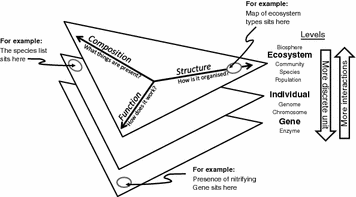
Fig. 1.1
The contemporary definition of biodiversity embraces three aspects of variation (differences in composition, structure and function) and several levels of biological organisation (from the enzyme, to the biosphere). There is not a right level to observe biodiversity, nor a right aspect to observe: ideally you should be capturing elements of all aspects and all levels, and be able to move seamlessly between them. In practice, in any particular situation there will inevitably be stronger emphases on some levels or aspects. Historically, many people considered biodiversity to consist only of composition, at the species level. Be guided primarily by what the users of the information need, secondly by what is observable using the available technology, and only then by what happened to have been collected in the past. As you shift downward from the ecosystem towards the organism and ultimately the gene, the entities with which you are dealing become more focussed and precise, but the price you pay is a loss of information about interactions between them and the emergent properties which arise from those interactions ( Source based on Noss )
It is well known that biodiversity is in world-wide decline (Butchart et al. ). There is little doubt that the current and projected rate of biodiversity loss exceeds its rate of generation. As a result, the world is getting poorer in terms of the biological variation it supports.
The loss of biodiversity has well-established immediate causes: the loss, degradation and fragmentation of habitat needed for the completion of life histories; over-harvesting of organisms which have commercial value (and the collateral damage to other organisms and ecosystems in the process); pollution of the environment by biocides and the waste products of human activity; and competition, predation or infection by invasive alien species deliberately or inadvertently introduced from other parts of the world are the leading causes (SCBD ). Climate change during the 21st century is projected to be high up on this list of the causes for biodiversity loss.
The contemporary decline in diversity is not entirely without precedent. On at least five previous occasions in the approximately five billion year history of this living planet, biodiversity has undergone relatively abrupt decreases (Leakey and Lewin ). In some cases, this has been the result of the rise to dominance of a new group of organisms, such as the evolution of oxygen-generating algae three billion years ago, which confined the previously dominant anaerobic bacteria to low-oxygen niches. In other cases, it is attributed to cataclysmic events such as the impact of an asteroid. Although previous episodes of biodiversity loss have left a lasting imprint on the biota of the world, biodiversity overall has always recovered, often in different forms. Disruption of the old order may even have been the stimulus for biological innovation. For instance, the end of domination by dinosaurs may have allowed a relatively obscure group of proto-mammals to evolve, ultimately, into our own species. Why then are we concerned about the current loss of diversity?
First, the current loss of biodiversity is just one element of an interconnected syndrome known as Global Change. Another element is climate change, mostly driven by human activities, including the burning of fossil fuels and release of other waste gases. A key driver of both climate change and biodiversity loss is the ongoing transformation of the surface of the planet due to human activities, including agriculture, deforestation, settlements, transport infrastructure, fishing and mining. Underpinning these changes have been transformations in how people organise themselves economically, politically, socially and technologicallythe accelerating processes of development, globalisation and modernisation. The fact that biodiversity loss is intimately connected to these other momentous reorganisations makes it both an indicator of changea canary in the mine, warning of potentially life-threatening dangersand a key part of that change itself. It also makes halting biodiversity loss difficult, because it requires addressing the development expectations of billions of people.
Second, although past extinctions appear sudden (and perhaps some of them were), the fossil record from which we derive much of our knowledge of them tends to distort our view of their actual rate. Previous episodes of species loss may have extended over many millions of years. The current loss of biodiversity is, by contrast, extremely rapid. Furthermore, although biodiversity in the abstract sense recovered from past crises, whole groups of affected species did not. From the particular perspective of our species, we run the risk of being in the latter group.
Third, despite amazing advances in biotechnology, the loss of biodiversity in its ultimate form (the global extinction of unique genetic lineages) remains effectively irreversible. It represents the loss of millions of years of evolutionary experimentation through mutation, adaptation and natural selection. With this loss, we lose options for the future, and knowledge of the past and present.

